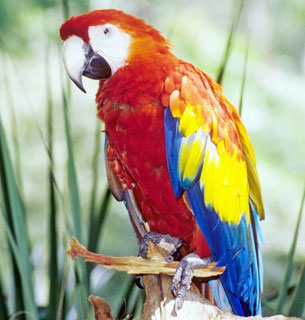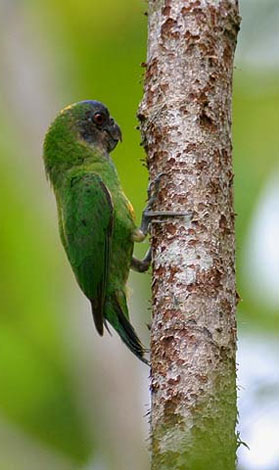Parrots
What are parrots?

Parrots are birds of roughly 372 species found in most tropical and subtropical regions. They only consist of three major groups:
Psittacidae ('true' parrots)
True parrots are more widespread than cockatoos, with species in the Americas, Africa, Asia, Australia and eastwards across the Pacific Ocean as far as Polynesia
They range from huge macaws, exemplified by the spectacular Scarlet Macaw to tiny parrotlets and lovebirds.
Cacatuoidea (cockatoos)
A cockatoo is any of the 21 species belonging to the bird family Cacatuidae. Thirteen of the 21 cockatoos are white or mostly white, including such large birds as the Sulphur-crested Cockatoo.
The family has a mainly Australasian distribution, ranging from the Philippines and the Eastern Indonesian islands of Wallacea to New Guinea, the Solomon Islands and Australia.
Strigopidae (New Zealand parrots)
The New Zealand parrots are a family of three unique parrots in New Zealand which are the Kea, Kaka and Kakapo.
What are the main features of a parrot?

Parrots range in size from the pygmy of the South Pacific which is only 3½ inches long to the hyacinth macaw which is about 10 inches long. Much of its length is in its long tail. Parrots weigh from just a few ounces to 3½ pounds. Most parrots are predominantly green, especially the ones from South America. Some American parrots are mostly blue or yellow. However, parrots may have red, green, blue, purple, white, pink, brown, yellow, and even black.
They have large heads and short necks. They also possess a strong, hooked beak that helps them crack nuts and have a thick muscular tongue. They feed their young by regurgitation to help them with digestion. Another unique and interesting parrot trait is their zygodactyl feet. They have two toes that point backwards and two toes that point forward. These toes make the parrot excellent climbers.
Smaller parrots live 10 to 15 years. Larger parrots such as the macaws and cockatoos live more than 75 years. These birds reach maturity in 1 to 4 years. Wild parrots live in the forest of tropical zones including South America, Australia, and New Guinea. A few live in Africa and mainland Asia. Parrots are hole nesters. They build their nests in holes in trees, termite mounts, rock cavities, or ground tunnels. A few exceptions will build stick nests.
Probably the thing that parrots are most famous for is their ability to talk. What they are actually doing is mimicry or imitation.
Oddly enough one of the more curious parrots facts is that they don't have vocal cords. They produce sound by pushing air out of their trachea and control their pitch by changing the shape and depth of the trachea.
With their impressive range of vocalizations parrots can mimic bells, buzzers and many other sounds in addition to human speech.
African Gray Parrots are said to be the best mimics of the parrot family. They are also highly intelligent and don't just mimic, but learn associations for the words they say.
Many can associate colors, shapes, numbers, sizes and more.
Parrots throughout history
Parrots have played a sizable role in history. There are Egyptian hieroglyphics going back 4000 years which indicate that they were pets of royal families. There are also references to them during the Greek and Roman times.
Many famous historical figures, such as Winston Churchill and King Henry VIII were parrot owners as well.
Parrot fossils that have been found in Europe show that the modern parrots ancestors go as far back as the Eocene period (see Geological Time) and are 50 million years old. Fossils that relate more closely to todays parrots in terms of bone structure and appearance are about 23 million years old.
Endangered parrots

Some species of the parrot have become endangered. It is often the result of habitat loss through clearing of trees for urban development or agriculture. Other species are endangered due to poachers, as in the case of the Scarlet Macaw. The Spixs Macaw is another one of the endangered species and there are only 7 in captivity. In the case of the New Zealand kakapo, this flightless parrot is critically endangered due to predation by introduced predators such as cats.
Currently the Convention on International Trade in Endangered Species (CITES) bans the sale of any wild-caught species, yet the parrots' popularity continues to drive illegal trade.